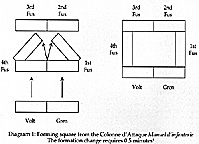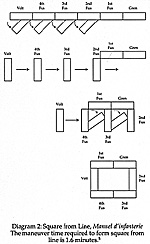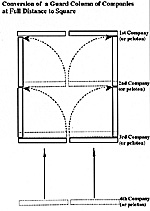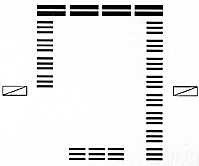PART II. MORE ON SQUARES by Jean A. Lochet
In mid February, George Nafziger sent me a copy of his latest brain child A Guide to Napoleonic Warfare, which contains a wealth of information [1] on tactics. The above article by George is an excerpt from that book.
From the above, it is quite clear that squares moved as fast as other formations. At COLD WARS 95, George and I discussed at length the question of squares and their mobility and the attack of the Middle Guard at Waterloo as described by General Petit, i.e. that it was carried out in squares. But before we go back to General Petit's report let us see some other pertinent points.
On Wargamers and the Speed of Squares
There are two kinds of wargamers. The first kind likes to play with one (or more) set(s) of rules, which may or may not be based on true Napoleonic tactics and is fairly satisfied with that. The second kind, the simulation wargamer, usually uses more sophisticated rules that, he likes to believe, are based on true Napoleonic tactics. [2]
At COLD WARS 95, I had the opportunity to talk to several wargamers about the subject, telling them that we had concrete evidence showing that squares moved faster than that which we have been led to believe. Everyone I contacted had a very skeptical attitude and even profound disbelief... So, obviously most wargamers have a clear and definite opinion about squares: they are slow moving formations.
Yet, in all the above examples given by George Nafziger, the squares moved at regulation speeds (even at charge speed!) and there is no evidence whatsoever to support that they moved as slow as many rules impose upon it.
Of course, when one professes that the Middle Guard at Waterloo attacked in squares, the reaction of most wargamers is: You have to be crazy, to attack with slow moving squares! That reaction is perfectly understandable since they base their conclusion on the erroneous understanding that squares were slow moving formations. Yet... General Petit should have known the difference between a square and a column!
The Different Types of Squares
I don't intend to cover extensively the formations of squares but just to cover the basics. Each nation formed it according to the requirements of its battalion organization. The French used the following procedures to form square. The French Reglement de 1791 set the formation of the square on 3 ranks on each face and the same principle was retained by the Manuel d'Infanterie. [3] We'll skip the procedure as the diagrams are self explanatory. Note that the adoption of the 6-company battalion in 1807 changed the French square into a rectangle.
Note that a square, although it is not mentioned in the Reglement or the Manuel d'Infanterie, was formed by facing the "side" companies forward, and moving the square forward. If the square in this moving formation was threatened by cavalry, it simply stopped and faced its "two side companies" in the proper direction, i.e. facing outside. That was quickly done.
Napoleon, the French Generals and the Cavalry Menace
There are numerous accounts clearly showing the respect that Napoleon and the French generals had for cavalry.
Diagram 1: Forming square from the Colonne d'Attaque Manuel d'Infanterie, Lesson 15, articles #76-82:
The formation change requires 0.5 minutes [4]
The maneuver time required to form square from line is 1.6 minutes. [5]
Before the Campaign of 1806, Napoleon wrote to Soult: [6]
"It appears that the most redoubtable item about the Prussians is their cavalry; but, with the infantry you have, and by always taking a position to form squares, you have little to fear. However, no mean of war must neglected...."
So, in essence, Napoleon simply said to Soult, a most able tactician, to be careful about the Prussian cavalry and be always ready to form square. Soult was a very careful tactician and had great respect for cavalry. That is well illustrated by the specific instructions sent before the battle of Austerlitz by Soult to his Divisional commanders: [7]
"The divisional generals were expressly urged to retain the formation of two lines of battle and one of light infantry, and to keep the battalions in columns of divisions, at platoon intervals, so they could operate with greater speed, while being able at any time to form square against cavalry. This arrangement was maintained throughout the action, and if some battalions deployed, it was only to present a greater extent of front to the enemy."
Note that with such a formation shown on Diagram 3, that Soult's Divisions could form interlocking, mutually supporting squares very quickly. (Soult's battalions in columns of divisions at platoon intervals could form squares quickly by a maneuver similar to that of Diagram 1.)
St.Hilaire's Division at Austerlitz (part of Soult's Corps)
(from Home's A Precis of Modern Tactics, London, 1882)
The very same cautious instructions to deploy his infantry in 2 lines had been ordered by Lannes and forming mutually interlocking squares in 2 lines proved to be a decisive factor in repelling the Allied cavalry.
Large Diagram St. Hilaire's (slow: 41K)
Many identical examples can be found in reliable sources.
The French Imperial Guard and Squares
The French Imperial Guard infantry was organized in 4-company battalions. Each company at full strength roughly occupied a frontage of 44 yards. Like the line infantry, the Guard used the line, the column of companies and the square, as per the Reglement of 1791. The square could be formed from the line or from the column of companies, (or other columns) as shown on the diagrams below.
General Petit's squares could be such a formation. It could be formed from an open column of companies as shown on the diagram below by wheeling #2 and #3 companies (courtesy of George Nafziger).
It is rather obvious that a "walking" square could simply form either square by simply facing frontward the #2 and #3 companies. If cavalry attacked, both companies would simply face "outside". There is nothing complicated here and the maneuver is made according to regulations!
Such a walking square would be some 27 yards by 27 yards or so (even less with reduced effective strengths). [8] It is not much different from a closed column of companies, which would have been some 27 yards by about 10 yards. Not a big difference on a battlefield obscured by smoke.
Macdonald's Square at Wagram
Macdonald's formation at Wagram was covered in EE&L 3. It was the result of long studies on that formation (see EEL 76, 77 and 118).
Macdonald's formation at Wagram is worth describing. We have been told by Oman, that at Wagram, Macdonald formed a monstrous column with some 23 battalions at very reduced strength.
It was formed by 8 battalions in double line, 4 battalions in columns of battalion one behind the other on the left, and 8 battalions in columns of battalion one behind the other on the right. The rear consisted of 3 battalions side by side.
In his memoirs, Macdonald claims that he adopted such formation for his attack because he feared an attack by the Austrian cavalry. Following is what Macdonald says in Marshal Macdonald's Recollections, p.338. MacDonald had formed part of his Division in 2 lines of 4 battalions each. Then, he closed his first line (of 4 battalions) on his second line (also of 4 battalions):
"...I therefore ordered four battalions, followed by four others which I deployed in two lines, to advance at the double; and while my artillery opened fire, and that of the Guard took position (which the Emperor called the hundred gun battery), my two divisions formed themselves into attacking columns. The enemy, who were still advancing, halted, and, redoubling their fire, caused us terrible damage. However, in proportion as my lines became unserviceable, I drew them up closer together, and made them dress as at drill. While I was doing this, I saw the enemy cavalry preparing to charge, and had barely time to close my second line on the first one (emphasis mine, JAL); they were flanked by two divisions still in columns, and the square was completed (emphasis mine, JAL) by a portion of General Nansouty's cavalry that had been put under my orders since the morning..."
So, as it can be seen from the above, Macdonald's formation at Wagram was neither a massive column as suggested by Oman nor ordre-mixte. Macdonald intended to form a square to repulse a threat of an Austrian cavalry charge, which materialized shortly after. The huge square was later on used as an assault formation to break through the Austrian lines and the Austrian artillery caused fearful damage to it.
The above should help somewhat to better understand the usage of squares on the battlefield. We'll be glad to receive comments (positive and negative) and answer questions from the readership.
Many of the above diagrams are reproduced (with the kind permission of George Nafziger) from A Guide to Napoleonic Warfare.
[1] Some of the information has already been published in many past issues of the old EE&L, authored either by George or the writer.
More Squares
Related:
This article appears in MagWeb (Magazine Web) on the Internet World Wide Web. Both types of wargamers consider squares as slow moving formations. Most rules allow squares to move at half speed or even slower than that. Believe me, it is a firmly entrenched belief!
Both types of wargamers consider squares as slow moving formations. Most rules allow squares to move at half speed or even slower than that. Believe me, it is a firmly entrenched belief!
 Diagram 2: Square from Line, Manuel d'Infanterie, Lesson fifteen, articles #76-82.
Diagram 2: Square from Line, Manuel d'Infanterie, Lesson fifteen, articles #76-82.



Conclusion
Acknowledgment:
Footnotes:
[2] The simulation type of wargamer is the kind that has played many different rules in the quest of playing a satisfactory, realistic Napoleonic battle. He has become such a wargamer because of the constant frustration he has experimented over the years with rules that do not allow a realistic battle.
[3] That is Manuel d'Infanterie ou resume de tous les reglements, decrets, usages et renseignements propres aux sous-officiers de cette armee, Paris, 1813.
[4] ref. Nafziger, George A Guide to Napoleonic Warfare, p. 45.
[5] ibid, p. 44.
[6] Letter to Marshal Soult from Wurzburg, October 5, 1806, at 11AM, Correspondence No. 10941. French text: "Il parait que ce qu'il y a de plus a redouter des Prussiens, c'est leur cavalerie; mais avec l'infanterie que vous avez, et en vous tenant toujours en position de vous placer en carres, vous avez peu a redouter. Cependant aucun moyen de guerre ne doit etre neglige..."
[7] During his attack on the Pratzen at Austerlitz, Soult's command had to make a long march in open country, i.e. ideal ground for cavalry. Hence his ideal formation could quickly form square.
[8] Each Guard battalion was on the average about 500 strong less any losses suffered at Ligny.
Back to Empire, Eagles, & Lions Table of Contents Vol. 2 No. 13
Back to EEL List of Issues
Back to MagWeb Master Magazine List
© Copyright 1995 by Emperor's Headquarters
Other military history articles and gaming articles are available at http://www.magweb.com